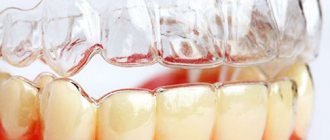People who want to have straight, beautiful teeth often wonder which dental structure to choose. Veneers or braces - which is better? In this article we will talk about the main differences between braces and veneers. Which option is best for you?
In this article
- What is the difference between veneers and braces?
- When can veneers be placed?
- When are braces better than veneers?
- What is the difference between veneers and braces?
- Veneers or braces - which is better?
- Is it possible to put braces on veneers?
- Conclusion
What is the difference between veneers and braces?
To understand the differences between braces and veneers, you need to take a closer look at their design. Braces are an orthodontic device that is aimed at correcting malocclusion and uneven teeth. It consists of small clasps that are fixed on the teeth according to a pre-designed pattern, and also a metal arch with shape memory. When an orthodontist places braces on crooked teeth or a jaw with a malocclusion, the pressure from the archwire begins to move the teeth into the correct position. This process is slow and can take from a year to 3 or more years. The duration of treatment will depend on the complexity of the pathology, the age of the patient and a number of other factors.
Veneers are a fundamentally different design. They can be compared to false artificial nails, which are imperfect real ones underneath. Only veneers are plates that imitate the shape and color of real teeth and look very natural. With the help of veneers, you can disguise chips, curvatures and other imperfections.
To understand whether to install veneers or braces, which is best for you, you need to understand what result you expect. And to do this, evaluate the indications for the installation of one or another dental structure.
Manufacturing and installation of bite correction systems
| Manufacturing and installation | ALINERS | BRACKETS | VENEERS |
| Preparation time | 7 days | 1-2 days standard | from 7 days to 30 |
| Installation time | from 45 minutes to 1 hour both jaws | 3-6 hours | each jaw 6-8 hours |
| The need to take impressions before installation | intra-oral scanning + impressions (optional) | Yes | Yes |
| The need to use anesthesia | No | No | Yes |
Any production of bite correction systems implies the patient’s obligation to make impressions
. Of course, with the help of a doctor. The procedure itself is inconvenient, but it must be done. Aligners are preferred here, since aligners are already digital, computer technologies, and intraoral scanners can be used in their work: the doctor ran such a scanner over the patient’s teeth, and the computer showed their appearance. All of your both jaws on the computer screen are as if they were alive. There is no need to take dental impressions. But, it’s true, not many clinics yet have such advanced technologies. Therefore, the advantage of aligners here is not particularly strong. Therefore, let's also compare the manufacturing and installation times of bite correction systems.
The fastest braces to make. The slowest ones are veneers.
Veneers or braces
? Standard braces are made for you within 1-2 days. The longest in production are veneers. This is understandable. In fact, each dental plate is sharpened for each of your teeth. Therefore, veneers can take up to 30 days. Aligners confidently hold second place - the standard production time is up to 7 days maximum.
The fastest to install are aligners.
Over time of installation
Braces take longer to install than aligners; it can take you up to 6 hours. Aligners are the easiest and fastest way: installation on both jaws will take a maximum of 1 hour. But with veneers you will have to suffer - since each jaw is glued from 6 to 8 hours.
Cost of treatment with aligners
Now you have the opportunity to get a beautiful smile at a cost:
- for the simplest case of correction with aligners from 4,000 rubles
per month - in the most difficult case of teeth straightening with aligners - less than 10,000 rubles
per month
In reality, Star Smile today has the lowest prices
in Russia for aligners compared to all aligner manufacturers! (Invisalign, Orthosnap, 3D Smile)
Find out all prices for aligners
Cost of treatment with aligners:
Star Smile also has the best prices for treatment with aligners in Russia, which covers more than 100 cities of the Russian Federation, since the company’s main goal is to make prices for aligners affordable for the vast majority of patients. You can see this for yourself - look at the prices for aligners.
When can veneers be placed?
Main indications for their installation:
- chipped teeth;
- non-carious pathologies that spoil the appearance of teeth (fluorosis, hypo- or hyperplasia);
- large gap between the front teeth;
- persistent darkening of tooth enamel;
- unsightly fillings that stand out against the background of the teeth and spoil the smile;
- wedge-shaped defect.
That is, the main purpose of veneers is cosmetic correction of the smile area. With their help, you can hide aesthetic imperfections in just a few procedures. It is important to understand that veneers are attached to the teeth as a “veneer” and simply mask the defect. They will not be able to correct abnormal bites, uneven teeth and other orthodontic disorders.
Seriously speaking, it is best to be treated with aligners
Why?
Yes, because they have a huge number of advantages over braces. There are only a few difficult dental pathologies that aligners cannot handle. But all other problems of crooked teeth are perfectly corrected by aligners! Star Smile is represented by orthodontists in more than 70 (!) cities of Russia. And we guarantee you the most comfortable prices for treatment with aligners! To make sure of this, leave a request for a FREE consultation with an orthodontist in your city. Do you want to visit an orthodontist completely free?
When are braces better than veneers?
There are other indications for wearing braces:
- Malocclusion (distal, open, mesial, deep, crossbite).
- Unevenly spaced teeth or entire rows of teeth.
- Impacted (unerupted teeth) when they need to be brought to the surface.
- Preparation for implant installation, prosthetics.
- Correction of jaw shape and facial profile.
It is clear that braces do not mask the problem, but radically solve it. They change the position of the teeth and the shape of the jaw, thereby eliminating the root cause of orthodontic problems.
What are Lumineers?
Lumineers are a separate type of dental coverings. They differ from veneers in thickness, which does not exceed 0.2 mm, and in the installation method. Due to the thinness of the plates, in most cases they are installed without grinding the tooth enamel. Lumineers are installed if there is no need to visually correct the shape of the tooth. The main disadvantages of lumineers are:
- Low strength. It is physically impossible to provide it with a minimum thickness of 0.2 mm;
- High price. Lumineers are the most expensive type of veneers.
What is the difference between veneers and braces?
These dental structures differ not only in design and functionality. They have many differences in other parameters.
- Material.
Braces can be made of metal, ceramics, sapphire, and plastic. Veneers are made from composite and ceramic materials, ceramic composite, and zirconium dioxide.
- Fixation zone.
The bracket system can be installed both on the outside and on the inside of the teeth. Lately, lingual braces (internal braces), which are invisible to others, have become popular. Veneers “mask the facade”, so they are always placed only on the outside of the teeth.
- The need for turning.
To install braces, you do not need to grind your teeth. After removal of the structure, the teeth will remain in their original condition if the patient properly cares for them during orthodontic treatment. To install veneers, you need to grind the tooth by 0.3-1 mm. This process is irreversible. If a person once wants to remove the overlays, the enamel will no longer return to its original appearance.
- Anesthesia during installation.
To install veneers, the tooth must be ground down quite heavily, so in most cases anesthesia is required. The process of installing the bracket system is painless, although the patient may experience slight discomfort when fixing the arch in the clasps. No anesthesia is required to install braces.
- Discomfort after installation.
Veneers do not cause feelings of pressure or pain after the installation procedure. This is due to the fact that, unlike braces, they do not apply force to the teeth, but only hide imperfections. After installation of veneers, the patient almost never feels pain. After installing braces - quite often. The stronger the malocclusion, the more pronounced the pain will be. The most severe discomfort will be in the first week after installation.
- Aesthetics.
In matters of beauty, braces, of course, are inferior to veneers. Even the most aesthetic and transparent sapphire braces are still visible to one degree or another on the teeth. In addition, they cannot hide crooked teeth or malocclusion. Veneers look beautiful and mask natural imperfections in the dentition.
- Doctor visits.
The entire cycle from the first visit to the doctor to the actual installation of veneers takes approximately 2-3 days, after which the patient is recommended to come for a scheduled appointment for examination once a year. A person with braces will have to visit the dentist more often. Depending on the type of brace system - once every 3-8 weeks. This is necessary for the specialist to adjust the traction force and monitor the effectiveness of treatment over time.
- Recovery period.
Correction with veneers does not involve a recovery period. After treatment with braces, you will have to wear special retention aligners for several more months, which allow you to maintain the achieved result, fix the teeth in the correct position, and prevent them from moving back.
- Specifics of care.
Onlays are much easier to care for because they are smooth, mimic natural teeth, and require proper care. Braces make oral hygiene significantly more difficult. To care for them, a toothbrush is usually not enough; special devices are required - brushes, single-beam, V-shaped brushes, super-flosses, irrigators. Without an integrated approach, it is impossible to achieve high-quality cleaning, which is fraught with the development of caries and other dental problems.
Intimate disadvantage of all braces
We specifically highlighted this minus as a separate item. Doctors are tactfully silent about this drawback of any brace systems, including lingual braces. But it exists. And it causes a lot of problems for those with braces. This is an injury, but not to the tongue, but to injury by parts of the braces to the mucous membrane of the sexual partner during intimate caresses: causing micro-scratches with possible infection of the wounds due to insufficient hygiene of the braces.
Such statistics are periodically published in the European and American press, where they really and openly talk about it. With veneers and aligners, this problem is absent or minimized: we always try to clean our teeth normally, but with braces it becomes more and more difficult to clean.
How are aligners made - invisible aligners for teeth?
To make aligners, the doctor at the clinic takes impressions of the patient’s jaws and sends them to the manufacturer of the aligners - to us, to the Star Smile company. Using a 3D scanner, a digital model of the teeth is obtained. The trajectory of the teeth is calculated and the required number of aligners is determined - from five to several dozen aligners. It all depends on the severity of the primary pathology.
The video shows how the digital jaw rotates, some lines appear along which the teeth line up. And soon this digital model will begin to come to life in the aligners. Star Smile has developed a unique software simulation of dental biomechanics. You see on the screen how all the lines are aligned, how the patient’s gums precisely move along with the teeth on the screen. This is very important - after all, future aligners should not cause any inconvenience and should fit perfectly on the patient, that is, unnoticed, producing the maximum effect of correcting the bite.
Next stage
— an order for future aligners is sent for 3D printing. Work on the production of aligners is carried out using 3D printers. As a result of digital 3D printing, accurate models of the patient’s teeth are obtained. Models of blanks for aligners are made step by step, that is, already in the dynamics of future treatment; for each stage, a different set of teeth is made.
Next stage
— a vacuum former comes into operation for the production of aligners. Blanks are placed on a special vacuum former mold - prototypes of future aligners. Thanks to super high-tech plastic, these blanks are light, transparent and will be invisible on the teeth.
Next stage
— the aligners acquire their exact geometry and are completely tailored to the anatomical features of the patient’s teeth and gums.
Finish stage
— packaging of manufactured aligners. All aligners are placed in individual sterile bags, listed according to the period of their wearing, and the patient’s name. The aligners have already acquired their own individuality.
All that remains is to put all the individual packages in the Star Smile branded box and the order is sent to your treating orthodontist at your dentistry.
How orthodontists install aligners
And so your aligners came to the doctor. In this video, orthodontist Alexey Trezubov talks in detail about the installation of aligners and shows how the aligners are installed and worn:
Is it possible to put braces on veneers?
Sometimes there are situations when a person wants to correct his bite using a braces system, but he already has veneers installed on his teeth. And then the question arises: is it possible or not to install an orthodontic device on top of veneers?
Dentists note that the presence of veneers is not a contraindication to installing braces. But the patient must be prepared for the fact that the braces will often come off the surface of the veneers, and this directly affects the effectiveness of orthodontic treatment. In addition, the onlays are quite fragile and can break under pressure, and when the teeth in the jaw shift, the position of the onlays will change and they will no longer hold on.
If a patient has veneers, a good orthodontist will not recommend treatment with braces, but will suggest an alternative way to correct the bite.
Seriously speaking, it is best to be treated with aligners
Yes, I want to book a free consultation on aligners in my city!
If braces and veneers - we all understand that they are visual and what they are, then aligners
- These are the lightest transparent mouthguards made of solid polymer.
When you put on the aligners, you see your entire dentition (the aligners become invisible).
And this is a plus for aligners
Also, the advantages of aligners include the absence of allergies, just like veneers. Braces cannot boast of this.
By the way, you can find out in 1 minute whether aligners are right for you or whether doctors will forcibly offer only braces: you need to answer only 9 express questions
.
But the main general advantage of braces is that they can be installed in childhood. Although, according to the scientific development department of Star Smile, aligners are now being developed for children from 7 years of age. If this works out, then the undisputed leadership in the overall comparison will go to the aligners.
Contraindications for installation
Veneers instead of braces are good if you only need to solve the aesthetic side of the issue, but installing them in case of severe bite pathologies leading to uneven load when chewing is impossible, because In this case, restorations cannot be made as aesthetically pleasing as possible; moreover, they will not last long, and will not solve health problems or correct functional disorders in the functioning of the maxillofacial apparatus.
Otherwise, the contraindications for installing both structures are similar:
- absence of a large number of teeth: however, orthodontic appliances can be installed in the absence of some units (for example, sixes and sevens),
- presence of prostheses and implants,
- gingivitis, periodontitis and periodontal disease,
- extensive caries,
- early age of the patient: braces cannot be installed until the final change of the primary bite to a permanent one occurs (i.e., not earlier than 14-16 years). Dentures cannot be placed until the enamel is completely formed and mineralized,
- decayed teeth,
- bruxism,
- mental disorders.
Cost of treatment
The cost of treatment is individual in each specific case, since all patients have different combinations of problems, and different solutions can be chosen. After diagnosis and discussion of treatment options, the Family Dental Clinic prepares an estimate for treatment, which indicates the cost of the upcoming treatment, payment stages and deadlines. In the clinic’s price list you can find out the cost of veneers, crowns, and other individual services, but to determine the cost of your particular treatment, you need an in-person consultation and additional diagnostics.
Dial-Dent specialists who took part in the treatment:
- Orthopedic dentist S.V. Zukor – diagnostics, development of a treatment plan, supervision of all stages, restoration of teeth with veneers.
- Dental neurologist E.V. Saxonova – treatment of bruxism.
- Implant surgeon V.P. Alaverdov – removal of wisdom teeth under sedation.
- Anesthesiologist M.S. Vakhrameev – conducting sedation, monitoring the patient’s condition during surgery to remove wisdom teeth.
- Dentist-endodontist Yu.A. Borisova – treatment of dental caries with a microscope, replacement of fillings.
- Orthodontist M.P. Sleptsova – teeth straightening.
- Hygienist T.V. Kondratieva – hygienic preparation for complex dental treatment, teeth cleaning before installing braces, professional hygiene during braces treatment, teeth whitening.
- Osteopathic doctor A.I. Popov – osteopathic correction during orthodontic treatment.
- Speech therapist-myofunctional therapist T.B. Tsukor – normalization of the tone of the muscles of the tongue and lips, strengthening the correct position of the tongue.
- Dental technician D.V. Wolf – making ceramic dental veneers.
- Dental assistants – L. Kharlamova, S. Shchelkova, M. Erkimbekova.
See other examples of the work of Dial-Dent specialists here.
Make an appointment for a consultation by phone +7-499-110-18-04 or through the form on the website. You can ask questions about dental treatment and dental prosthetics to the chief physician of the clinic, Sergei Vladimirovich Tsukor, at
Which designs are still better to give preference to?
Veneers or braces: which is better? It is impossible to answer this question unambiguously, because... the designs have too many differences to compare them with each other. Moreover, reviews from experts suggest that it would not be entirely correct to make comparisons here, because the goals of the structures are the same, but the tasks are completely different. Braces “work” on a large scale and ultimately help solve not only aesthetic problems, but also health problems (headaches, gastrointestinal disorders, impaired diction and articulation, the risk of developing dental diseases). With the help of veneers, you can change your smile quickly and with minimal discomfort1, but they act only locally and are suitable when the defects do not cause any inconvenience other than aesthetic ones.
Patients often think that it is better to get veneers, because... it’s faster, more beautiful and cheaper, but you have to wear braces for a long time, and not everyone likes their appearance. However, thin overlays are unable to cope with serious bite pathologies, but braces today can be quite comfortable and beautiful. In addition, veneers cannot be installed for life (the service life is from 5 to 15 or more years depending on the type), sooner or later they will have to be replaced, and they are less durable than the enamel of natural teeth, which is preserved after wearing braces.
To make your choice, you need to visit a doctor and undergo a consultation. Only a specialist will help you make the right decision based on the clinical situation, the condition and appearance of the teeth, and associated problems.
Help from a myofunctional therapist
Myofunctional therapist T.B. Zukor has developed exercises that establish and secure the tongue in the correct position. This is necessary to achieve a stable result in correcting the position of the teeth.
If you do not work with the tongue, then its incorrect pressure will eventually negate all the work of the braces, and the teeth will begin to unfold again. At Dial-Dent, orthodontists work in close collaboration with a myofunctional therapist, which significantly reduces the time spent wearing retention equipment after removing braces.
Treatment of bruxism
The diagnosis was made by dentist-neurologist E.V. Saxonova after examination: brux behavior, hypertonicity of the masticatory muscles with the formation of pathological spasm.
To treat bruxism, that is, to eliminate severe clenching and grinding of teeth, injections of a drug containing botulinum toxin are prescribed into the masticatory and temporal muscles. Treatment with botulinum toxin preparations (Botox, Lantox) gives a good effect for bruxism, relieving excess tension and reprogramming muscle function. Additionally, the patient is recommended to monitor the condition of the masticatory muscles during the day, consciously relaxing them.
Crowded teeth are a serious defect that requires treatment.
Crowded teeth are teeth that, due to the lack of space for growth, are arranged so tightly that they overlap each other, sometimes even turning around their axis. Lack of space on the dental arch can occur for several reasons:
- if the jaw bone has not grown to the required size;
- if the tooth turns out to be redundant or has larger dimensions;
- with early loss of a baby tooth, when the vacant space on the arch was not filled with prosthetics;
- in the presence of pathologically located eighth molars;
- as a result of bad habits - prolonged pacifier sucking, which has developed into thumb sucking, mouth breathing, etc.
This pathology needs correction, since food debris accumulates in the spaces between unevenly standing teeth, creeping on top of each other, and a soft plaque is formed, which transforms into hard subgingival deposits. Even with great desire and patience, quality oral care becomes impossible. The consequences are well known: first - caries and periodontal diseases, subsequently - periostatitis, abscesses and fistulas, as well as pathological mobility of teeth and their premature loss. How to deal with a really serious problem?
Treatment of caries with a microscope
The removal of old fillings and treatment of dental caries was carried out using a microscope by endodontist Yu.A. Borisova. The microscope helps to better see the boundaries of the filling material when removing old fillings, the area affected by caries, thereby improving the quality of treatment and preserving maximum tooth tissue (microinvasive treatment).
Treatment was carried out over several visits. A total of 15 teeth were treated, old fillings were replaced with fillings made of light-curing composite in the color of the teeth, and the physiological shape of the teeth was restored.
Teeth whitening ZOOM 4
Since the patient wanted her smile to become brighter, it was proposed to whiten her teeth so that the light color of the restorations would harmonize with the color of the rest of her teeth.
Modern and safe teeth whitening ZOOM 4 was performed, which uses an LED lamp to activate the whitening gel.
Whitening makes your teeth several shades lighter.
Indications for installation
When it is necessary to use braces: any, even the most serious, malocclusion pathologies, disorders of the maxillofacial apparatus and health associated with the curvature or abnormal location of one, several or all teeth in the oral cavity. Also, wearing a brace system can become a preparatory stage for subsequent prosthetics with the same veneers or, for example, crowns.
Read the article on the topic: why are braces needed and should they be installed?
When the use of veneers is necessary: the presence of chips and stains on the enamel, dark color and yellowness of the enamel, the desire to hide the presence of fillings, diastema, fluorosis, hypoplasia, increased abrasion and sensitivity of the enamel, slight curvature of the front teeth, correction of their shape and position. The installation of veneers is also recommended for those patients who do not want to be content with the external appearance that nature has endowed them with, because the veneers allow one to achieve ideal proportions of appearance.
On a note! If the question is how best to straighten your teeth, then you need to choose braces, because... they have a therapeutic effect and specifically correct bite pathologies, but thin overlays only hide defects and level out minor bite anomalies, but you will not get any therapeutic effect from their use.
As you can see, the purposes of the systems are different. Veneers are micro-prostheses and hide external imperfections in a smile, i.e. solve the aesthetic side of the issue. And braces are orthodontic devices that treat, but with their help you cannot change the original color of the teeth or hide the fact of the presence of fillings, stains and chips.
How long will you have to wait for the result?
Braces exert mechanical pressure on the teeth, due to which they move in the direction specified by the doctor and are gradually aligned. However, this process is not quick, and the patient will have to be patient, because treatment can take more than one year. Especially in those patients who get braces at the age of 30 or later, when the bone structure of the maxillofacial apparatus is already fully formed. Also, do not forget that after treatment with orthodontic appliances you will definitely have to wear retainers, which will help consolidate the result and prevent teeth from moving in the opposite direction. Retainers will need to be worn several times longer than the braces themselves. Sometimes they have to be worn periodically throughout the rest of their lives if the bite has been severely disturbed.
Getting a beautiful smile with veneers would seem to be much faster and easier. You won't have to wait long. Here you just need to spend time waiting for the onlays to be made (in the laboratory this process can take from 1 week to a month), plus make several visits to the dentist and spend several hours in the dental chair. However, here too, patients are sometimes disappointed with the results.
“I wear ceramic veneers, and I’m very pleased that I managed to do without braces. But my situation was not complicated: a pair of front teeth were slightly crooked. By the way, I installed veneers despite negative examples and negative experiences of my friends. I have a friend whose doctor also put on onlays for a minor defect, but they quickly became unusable, and her teeth looked very unpresentable under them. The friend herself later really regretted that she refused treatment with braces!”
Venera, review from correspondence on woman.ru











